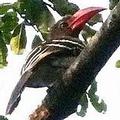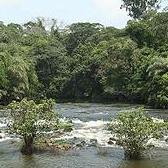 長期交惡的獅子山共和國與賴比瑞亞,為森林保育化解衝突,共界跨國界國家公園。兩國元首15日在獅子山境內的戈拉森林(Gola Forest)會面,宣布建立跨國和平公園。跨國公園的面積達2000平方公里,是西非上幾內亞(Upper Guinea)僅存大型的完整雨林之一,此舉將連結兩國境內的戈拉森林。
長期交惡的獅子山共和國與賴比瑞亞,為森林保育化解衝突,共界跨國界國家公園。兩國元首15日在獅子山境內的戈拉森林(Gola Forest)會面,宣布建立跨國和平公園。跨國公園的面積達2000平方公里,是西非上幾內亞(Upper Guinea)僅存大型的完整雨林之一,此舉將連結兩國境內的戈拉森林。
獅子山總統科羅馬(Ernest Bai Koroma)與賴比瑞總統亞希爾麗夫(Ellen Johnson Sirlear)表示,這座公園將紀念獅子山與賴比瑞亞兩國長年之間的衝突。兩位元首表示,和平公園設有安全區,在區域內禁止各項武裝衝突。跨國公園將促進跨邊界行動策略的開展,以阻止非法行動,並帶動公民社會與社會團體確保雙方的利益。
1990年代到2003年間,爭奪獅子山鑽石產業的主導權是造成兩國衝突的主因。
科羅馬總統表示:「保育戈拉森林的長期利益遠遠超過搾取與破壞森林的短期利益。就如同我在2007當選時所說的,戈拉森林將成為獅子山的國家公園,且將禁止礦業發展。」希爾麗夫總統則表示該計畫必須作為「兩國在此一區域,承諾和平、穩定與保育生物多樣性的象徵。」她表示,賴比瑞亞政府已將內30%的森林納入森林區域網絡,其中也包含戈拉森林。
透過酋長與國會議員,獅子山的地方社群對保育戈拉森林與指定為國家公園的結果表示支持。
此外,兩國政府也對碳交易與「減少毀林及森林退化造成的溫室氣體排放」(REDD)在發展中國家的進展表示關注。REDD方案可提更已開發國家碳排額度,以鼓勵其資助發展中國家的森林保育計畫。12月在哥本哈根舉行的聯合國氣候會議中,REDD 方案期望可成為氣候變遷協議的一部分。
 在未來的數十年內,和平公園可望募集到數百萬美元的經費,確保長期的金援以管理保護區並維持社區發展。
在未來的數十年內,和平公園可望募集到數百萬美元的經費,確保長期的金援以管理保護區並維持社區發展。
上幾內亞森林生態系 (Upper Guinea Forest Ecosystem )為世界上生物多樣性最豐富的生態系統之一。估計當初原有超過42萬平方公里的林地,但幾世紀以來,人類活動已導致超過70%的森林覆蓋喪失。而剩下的的森林支離破碎將棲地限制在孤立的小區域內,威脅特有動植物的生存。
保育團體「國際鳥盟」表示,該區域內有250種仰賴森林資源的鳥類,超過25種正受到威脅,或為侷限分布物種(restricted-range species)。森林內同時也居住超過50種哺乳類,諸如森林象、侏儒河馬與10種靈長類,其中也包含瀕危的黑猩猩。
The presidents of Sierra Leone and Liberia met Friday in the Gola Forest of Sierra Leone to announce the establishment of a new Transboundary Peace Park that will unite the Gola forests in both countries. The transboundary park will protect about 2,000 square kilometers, one of the largest remaining stretches of intact rainforest in the Upper Guinea area of West Africa.
President Ernest Bai Koroma of Sierra Leone and President Ellen Johnson Sirleaf of Liberia said the park will stand as a memorial to the long years of conflict in both Liberia and Sierra Leone.
It will provide security zones through which no armed conflict can be waged, the leaders said. The transboundary park will facilitate a strategy for cross border movement to prevent illegal activities and bring civil society groups and communities to protect the interest of both countries, they said.
Control of Sierra Leone's diamond industry was a primary cause of the conflict that raged throughout the 1990s and into 2003.
President Koroma said, "The long-term benefits of the conservation of the Gola forests far outweigh the short-term benefits of extraction and destruction. As I have said since I was elected in 2007, the Gola forests will become a national park in Sierra Leone and mining will not be permitted."
President Johnson Sirleaf said the project must be "a symbol of our renewed commitment to peace, stability and biodiversity conservation in this region."
She said the government of Liberia has set aside 30 percent of its forests to be included a network of forest areas, which includes the Gola Forest.
The local communities in Sierra Leone, through their traditional chiefs and Members of Parliament, have expressed their support for the conservation of the Gola Forest and its designation as a national park.
Both governments have expressed interest in carbon trading and in the process of Reducing Emissions from Deforestation and Forest Degradation in Developing Countries, or REDD.
The REDD process of offering credits to developed countries that fund forest protection in developing countries may become part of the climate change agreement expected to emerge from the UN climate conference in Copenhagen in December.
The Peace Park will provide the potential to raise tens of millions of dollars over coming decades, ensuring sustained funding for protected area management and community development.
The Upper Guinea Forest Ecosystem, which extends from Guinea to Togo, is one of the world's most biodiversity-rich ecosystems. But centuries of human activities have led to the loss of more than 70 percent of the overall forest cover, which was initially estimated at 420,000 square kilometers.
The remaining forest is fragmented, restricting habitats to isolated patches and threatening unique plants and animals.
Of the 250 forest-dependent birds in the region, more than 25 are threatened or restricted-range species, says BirdLife International. The forest is also inhabited by more than 50 mammal species, such as forest elephant, pygmy hippo, and 10 species of primates, including the threatened chimpanzee.



